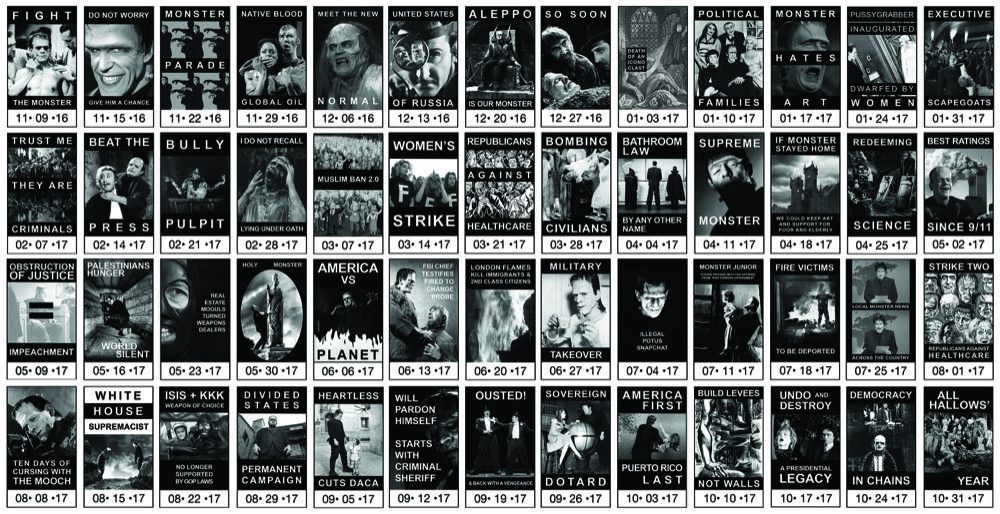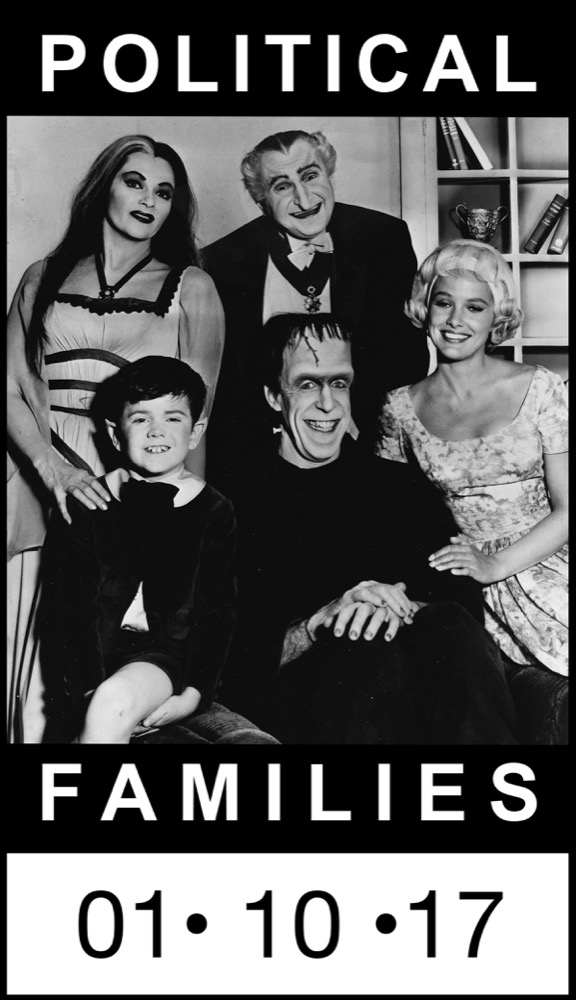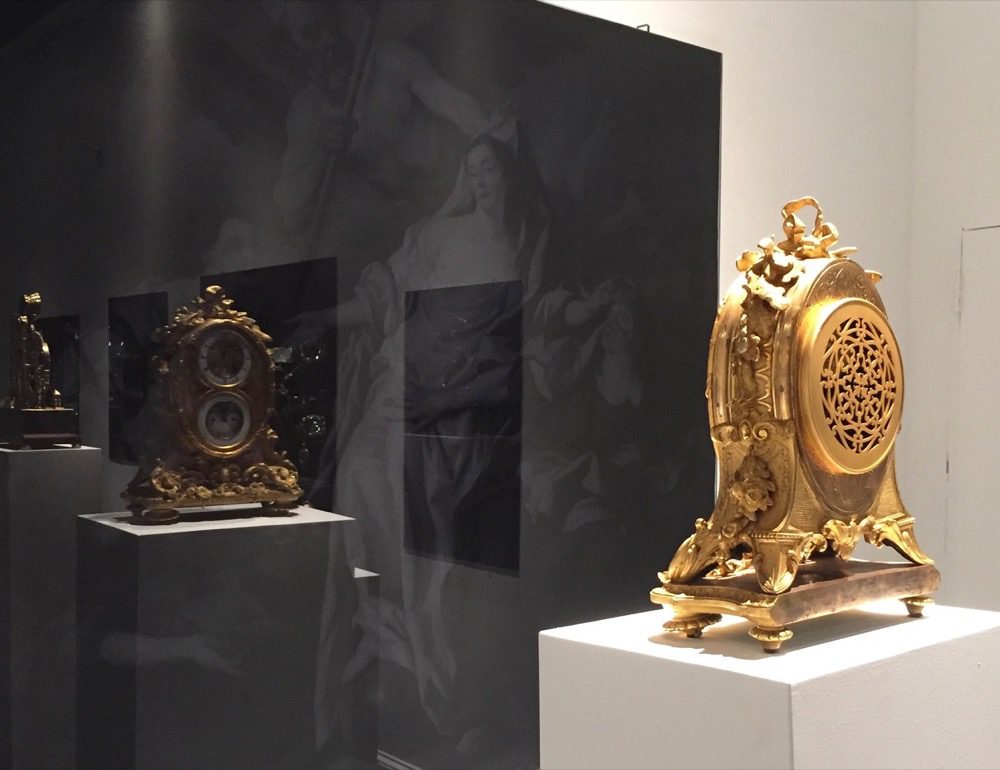Monster Parade: Pedro Lasch in “Prospect.4: The Lotus in Spite of the Swamp”
Ann Hackett looks at two series of works by Pedro Lasch featured in Prospect.4 at the Contemporary Arts Center and at M.S. Rau antique shop.

Pedro Lasch, Weekly Monster, 2016–17. Social media posts and 53 archival prints. Courtesy the artist.
Each week since November 8, 2016, the day Donald Trump was elected President of the United States, artist Pedro Lasch has posted a picture to a Facebook page called Weekly Monster.
Recently on view at the Contemporary Arts Center (CAC) for “Prospect.4: The Lotus in Spite of the Swamp,” the images, which are the same ones Lasch posted to Facebook, are representations of Victor Frankenstein’s creation. One of pop culture’s most recognizable monsters, he originates from Mary Shelley’s 1818 novel, which tells the story of a scientist who brings to life, and is later horrified by, a human-like creature.
For Prospect.4, Lasch’s images—most frequently of actor Boris Karloff’s monster from Frankenstein (1931), Bride of Frankenstein (1935), and Son of Frankenstein (1939)—are printed in black and white on vinyl and were affixed in a grid to a wall on the CAC’s first floor. The artworks’ titles and accompanying text are reflective of the week’s political news when they appeared on Facebook.
These titles, printed in white in all caps on black are representative of both the monster’s terse, monosyllabic speech and the political shorthand that we hear again and again from reporters, pundits, and politicians to describe Trump and his presidency: “VOTE FRANKENSTEIN,” “FIGHT THE MONSTER,” “DO NOT WORRY GIVE HIM A CHANCE,” “MONSTER PARADE,” “MEET THE NEW NORMAL,” “UNITED STATES OF RUSSIA,” etc.
The first image was a simple headshot of Karloff’s monster. He is shown straight-on with his square head, his stringy black hair glued to the scalp. The skin of his forehead is fastened to his skull with metal clamps above the familiar bolts through his neck. Lit from below, he is scary and a little pathetic.

An image from Pedro Lasch’s Weekly Monster, 2016–17. Social media posts and 53 archival prints. Courtesy the artist.
The metaphor does not proceed as straightforwardly in every image, which is a relief, shifting from Trump to others and preventing the project from feeling too simplistic. In ALEPPO IS OUR MONSTER 12.21.2016, the monster is chained to a chair. By showing him trapped, Lasch points out that many parties are guilty in the human-rights crisis in Aleppo, which has paid the price of the action and inaction of countries around the globe.
Others provide some comic relief. In POLITICAL FAMILIES 1.10.2017, Lasch chooses a still from The Munsters with the monster family posed on the living-room couch. MILITARY TAKEOVER 6.27.2017 shows Karloff backstage in full monster makeup sipping tea and eating toast.
In Shelley’s story, Dr. Frankenstein’s monster is not evil, but instead a reflection of his creator, just as some have said that Trump is the president we, a country obsessed with political scandal and reality TV, have created and deserve.

Installation view of Pedro Lasch’s Reflections on Time, 2017, at M.S. Rau, New Orleans, as part of “Prospect.4: The Lotus in Spite of the Swamp.” Courtesy the artist.
Lasch also dealt in reflections in his other installation for Prospect.4, part of his Black Mirror series, installed in a room at M.S. Rau antique shop in the French Quarter. In Reflections on Time, 2017, Lasch positioned black plexiglass rectangles with printed images mounted behind them next to antique clocks and objects, some from the gallery’s collection. When looking at the work, viewers simultaneously observed the image, the reflection of the clock, and themselves.
One work presents a reproduction of Jean-Francois de Troy’s 1733 painting Time Unveiling Truth, which depicts a winged male figure unveiling a female figure, paired with a perpetual calendar clock designed by Scottish jewelers Muirhead & Son.
Here, Lasch wants the viewer to reconsider the limitations of time, bringing together clock and image and viewer, all from different centuries, together in the reflection of his black mirrors. Perhaps he was thinking of Paul’s Biblical letters to the Corinthians, which also considered the connection between time and personal reflection: “For now we see in a glass, darkly; but then face to face.”
Editor's Note
Works by Pedro Lasch were on view November 18, 2017–February 25, 2018, at the Contemporary Arts Center (900 Camp Street) and M.S. Rau (630 Royal Street) in New Orleans as part of “Prospect.4: The Lotus in Spite of the Swamp.”



